Disclosure: We may earn commissions if you purchase products after clicking on a link from our site.
Do you have fishing for paddlefish on your bucket list? Do you want to experience what it is to catch paddlefish? Would you like to experience paddlefish snagging? Do you want to learn how to catch paddlefish?
Paddlefish is a prehistoric fish that is closely related to sturgeon. It is a filter feeder that feeds on tiny zooplankton.
It has a distinct paddle or rostrum on its head that works as an antenna which directs it toward weak electrical fields that are emitted by plankton. In this article, we discuss how to fish for paddlefish and other information about this ancient fish.
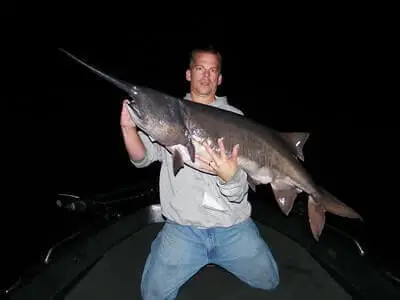
Table of Contents
How To Identify Paddlefish
A paddlefish resembles a shark with its long body, gray coloring, and fanned tail. It has a flat paddle-shaped snout which is about one-third of its body. Paddlefish can grow as long as seven feet.

Where To Catch Paddlefish
Paddlefish are found in slow-moving waters from Alabama to Texas and the Gulf of Mexico. They are found in the Yellowstone and Missouri Rivers as well as the Mississippi, Ohio, and Arkansas Rivers.
How To Catch Paddlefish
1. Snagging
Snagging is one of the primary methods used to catch paddlefish. Anglers typically employ heavy-duty fishing rods equipped with stout hooks and sturdy lines to target these prehistoric fish. Snagging involves casting or dropping the rig into the water and then jerking or “snagging” the bait through the water in hopes of hooking onto the paddlefish’s tough, cartilaginous mouth.
Due to their unique feeding behavior and anatomy, paddlefish are often caught using this technique, especially during their spawning migrations in rivers and reservoirs. Anglers should be mindful of local regulations regarding snagging, as it may be restricted or prohibited in certain areas. For more information on snagging regulations and best practices, paddlefish snaggers can consult resources provided by authoritative sources such as the U.S. Fish and Wildlife Service.
2. Trolling
Trolling is another effective method for targeting paddlefish, particularly in larger bodies of water such as reservoirs and large rivers. Anglers typically use specialized trolling rigs equipped with heavy-duty rods, sturdy lines, and large diving or planer boards to present baits or lures at various depths and distances from the boat.
When trolling for paddlefish, anglers often use large, brightly colored spoons or spinners, which can mimic the baitfish paddlefish feed on. The key to successful trolling for paddlefish is covering a wide area of water and presenting baits or lures at the appropriate depth where paddlefish are likely to be found.
Anglers should adjust trolling speed, depth, and lure presentation based on water conditions, paddlefish behavior, and other factors. It’s essential to check local regulations regarding trolling equipment and techniques, as restrictions may apply in certain areas. For more information on trolling regulations and best practices, anglers can consult resources provided by authoritative sources such as the U.S. Fish and Wildlife Service.
3. Jug Fishing
Jug fishing is a popular and effective method for catching paddlefish, especially in slow-moving rivers and reservoirs. Anglers use large, brightly colored jugs or floats equipped with baited hooks and anchored to the bottom with heavy weights. The jugs or floats drift along with the current, presenting the bait at various depths and locations where paddlefish are known to congregate.
Anglers often use natural bait such as cut bait or whole fish to attract paddlefish to the area. Once a paddlefish takes the bait and pulls on the line, the jug or float will bob or move, indicating a bite. Anglers then retrieve the jug or float and carefully reel in the paddlefish. Jug fishing is a passive technique that allows anglers to fish in multiple locations simultaneously, increasing their chances of success.
However, anglers should be vigilant and regularly check their jugs or floats to prevent tangled lines or lost fish. It’s important to adhere to local regulations regarding jug fishing, including restrictions on the number of jugs or floats allowed per angler and any size or gear limitations. For more information on jug fishing regulations and best practices, anglers can consult resources provided by authoritative sources such as the U.S. Fish and Wildlife Service.

Paddlefish Fishing Tackle
The fishing gear for paddlefish is simple since it does not take the bait. A big game spinning rod with a 30-plus pound test line, a weight of about 6 to 10 ounces tied to the end of the line, and a 10/0 or 12/0 treble hook about a foot or more above the loop.
Best Baits For Paddlefish
- Cut Bait
Cut bait, particularly from oily fish like shad or herring, is a popular and effective option for targeting paddlefish. Anglers typically cut the bait into large chunks and present it on heavy-duty hooks rigged with sturdy lines.
When fishing for paddlefish with cut bait, anglers often employ techniques such as snagging or bottom fishing. The strong scent and oily nature of the cut bait can attract paddlefish, enticing them to strike. Anglers should use caution when handling and rigging cut bait to ensure it stays securely on the hook during casting and retrieval.
It’s essential to check local regulations regarding the use of cut bait and any restrictions on baitfish species. For more information on using cut bait to catch paddlefish, anglers can consult resources provided by authoritative sources such as the U.S. Fish and Wildlife Service.
2. Live Bait
Live bait, such as small fish or worms, can be an excellent choice for targeting paddlefish, especially in areas where live bait is permitted. Anglers often rig live bait on heavy-duty hooks and present it using techniques like bottom fishing or drifting.
Live bait can provide paddlefish with a more natural and enticing presentation, increasing the chances of a successful hook-up. When using live bait to catch paddlefish, anglers should ensure the bait remains lively and active to attract the attention of passing paddlefish.
It’s important to adhere to local regulations regarding the use of live bait, including any restrictions on baitfish species and size limits. For more information on using live bait to catch paddlefish, anglers can consult resources provided by authoritative sources such as the U.S. Fish and Wildlife Service.
3. Dough Bait
Dough bait, made from a combination of flour, water, and various attractants, can be a convenient and effective option for targeting paddlefish, particularly for anglers fishing from shore or in areas with limited access to live bait.
Anglers typically mold the dough bait around a hook or bait holder and present it using techniques like bottom fishing or drifting. The scent and texture of the dough bait can attract paddlefish, enticing them to strike. Anglers may also enhance the effectiveness of dough bait by adding additional attractants such as fish oil or flavorings.
It’s essential to check local regulations regarding the use of dough bait and any restrictions on bait ingredients. For more information on using dough bait to catch paddlefish, anglers can consult resources provided by authoritative sources such as the U.S. Fish and Wildlife Service.
Best Lures For Paddlefish
- Spoons
Spoons are a popular choice among anglers targeting paddlefish due to their ability to imitate the fish’s natural forage. These lures feature a curved, metallic design that creates a wobbling action when retrieved through the water, resembling injured baitfish.
Anglers can vary the retrieval speed to adjust the depth at which the spoon operates, allowing them to target paddlefish at different depths in the water column. When using spoons to catch paddlefish, anglers should cast them upstream and allow them to drift naturally with the current, mimicking the movement of injured prey.
It’s essential to choose spoons of appropriate size and weight to match the forage available to paddlefish in their habitat. For more information on using spoons to catch paddlefish, anglers can consult resources provided by authoritative sources such as the U.S. Fish and Wildlife Service.
2. Inline Spinners
Inline spinners are another effective lure choice for anglers targeting paddlefish, particularly in rivers and streams where current is prevalent. These lures feature a spinning blade mounted inline with the body, creating a flash and vibration that can attract paddlefish from a distance.
Anglers should cast inline spinners upstream and retrieve them slowly, allowing the blade to spin and attract the attention of paddlefish as it moves through the water. The vibration and flash produced by inline spinners can trigger aggressive strikes from paddlefish, making them a valuable tool for anglers pursuing these elusive fish.
It’s essential to experiment with different blade colors and sizes to determine what paddlefish are most responsive to in a given environment. For more information on using inline spinners to catch paddlefish, anglers can consult resources provided by authoritative sources such as the U.S. Fish and Wildlife Service.
3. Soft Plastics
Soft plastic lures, such as swimbaits or worm imitations, can be effective for targeting paddlefish, especially in areas with abundant vegetation or structure. These lures feature a lifelike appearance and texture that can entice paddlefish into striking.
Anglers can rig soft plastics on weighted hooks or jig heads and present them using techniques like casting and retrieving or jigging. When fishing with soft plastics for paddlefish, anglers should focus on areas with submerged vegetation, fallen trees, or other structures where paddlefish are likely to congregate.
It’s essential to experiment with different colors and sizes of soft plastics to determine what paddlefish prefer in a given environment. For more information on using soft plastics to catch paddlefish, anglers can consult resources provided by authoritative sources such as the U.S. Fish and Wildlife Service.
How To Clean Paddlefish
Start cleaning a paddlefish by hanging it by the nose at a convenient height or placing it on a flat surface. On one side, start cutting through the flesh of the fish until you go full circle from the tail through the entire length on one side and back to the other side of the tail.
After cutting off the flesh on one side, turn the fish over and do the same thing. Start from one side of the tail and cut through the flesh until you complete the circle.
When completed, you will have two big slices of the spoonbill’s flesh that are separated from the backbone. You can then slice the skin off the flesh of the fish.

Paddlefish Fishing Tips
- Paddlefish is one of the largest of the freshwater species.
2. Spoonbill is a filter feeder; therefore, snagging is the fishing method used for catching paddlefish with heavily weighted treble hooks.
2. It is a protected species in many states. Get to know the state’s fishing laws before fishing for paddlefish.
3. Paddlefish feed on zooplankton.
4. Snagging can be physically challenging as it is a continuous cycle of casting, swinging, and retrieving until you get a spoonbill hooked.
5. Paddlefish can be found near the bottom often in deep holes near drop-offs.
6. Broomstick-like rods, braided lines, heavy weights, and large treble hooks are used when fishing for paddlefish.
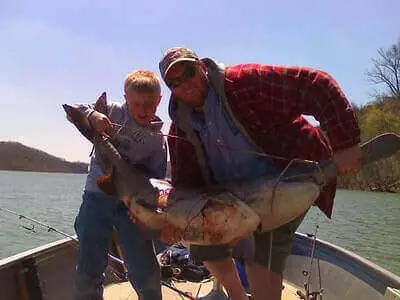
7. As the spawning season approaches with spring rains, paddlefish are found in deep holes preparing for spawning.
8. When snagging for spoonbills, you want to avoid having extra slack on your line. Your hook will drift through the water if there is any slack on the line. The hook should move precisely on a taut line rather than drifting when snagging.
9. Snagging depends on water temperatures and flow. With water temperatures in the range of 50 to 55 degrees Fahrenheit and when the flow increases, paddlefish migrate upstream to spawn.
10. Trolling is another fishing method that is used by anglers when fishing during paddlefish season.
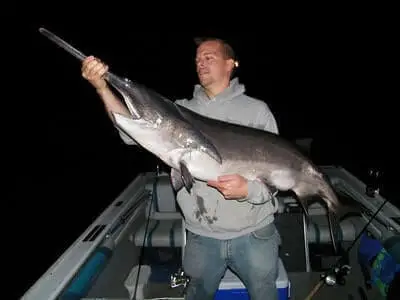
11. Spawning is triggered by a combination of daylight, water temperature, and water flow.
12. A 6 to 7-foot rod with a level-wind saltwater reel spooled with a 100-pound test braided line will work when fishing for paddlefish. Attach a large, teardrop-shaped 8- to 16-ounce sinker to the end of the line.
13. Use heavier weights in deep water or where there is a current. Alternatively, use lighter weights in slack waters or when the fish is suspended instead of being close to the bottom.
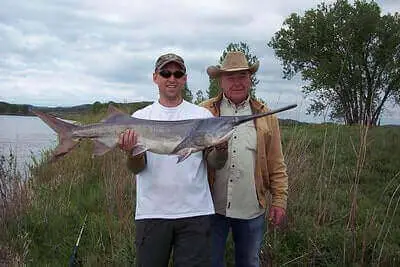
14. Treble hooks are used when fishing for paddlefish and No. 8 to No. 14 treble hooks are often used on the line. Anglers use two hooks: one about 18-24 inches above the weight, and the other 2 feet farther up.
15. Take along plenty of extra hooks and weights because you will lose some when fishing during paddlefish season.
16. Take along leather gloves; they give you a better grip and protect your hands from the line.
17. Landing gaffs can be very useful when fishing for paddlefish.
18. Always have heavy needle-nose pliers in your tackle box to remove hooks from the fish’s tough skin and to reshape bent hooks when fishing for paddlefish.

19. Small metal files are very helpful to sharpen large hooks that may not be sharp enough for snagging.
20. Paddlefish is measured from the eye to the fork of the tail. You will need a way to measure the fish. Take along a ruler or tape measure.
21. Take along short pieces of heavy nylon or cotton rope that are cut into 4-5 foot lengths. They will be needed to tie fish that are too big for live wells alongside the boat.
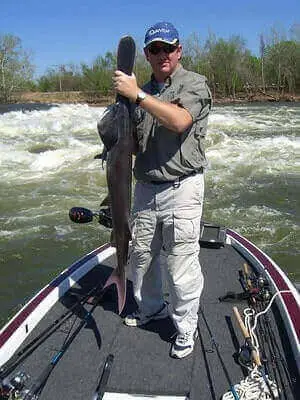

The Bottom Line
Paddlefish, also called spoonbills, are filter feeders that feed on zooplankton. It is a family of ray-finned fish from the order of Acipenseriformes. It is cartilaginous which means that it has no bones. It also doesn’t have any scales. Paddlefish are closely related to surgeons.
Anglers fish for paddlefish using snagging since it doesn’t take the bait. Trolling is another fishing method that is sometimes used when fishing for paddlefish. It is one of the largest species of freshwater fish. They are bottom feeders with a toothless mouth. Paddlefish snaggers have a great time during the snagging season going after paddlefish in open water.
In this article, we shared information on how to catch paddlefish to help you be successful when fishing for spoonbills. You can also read how to catch sturgeon which is closely related to paddlefish.